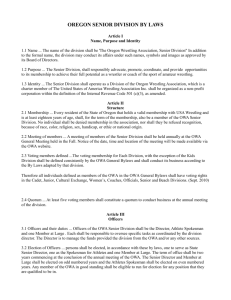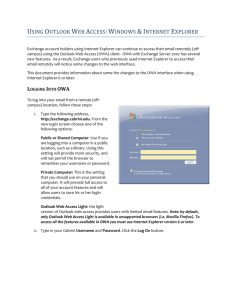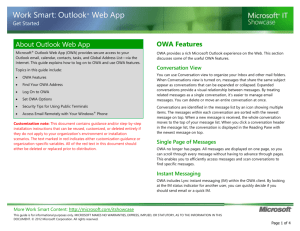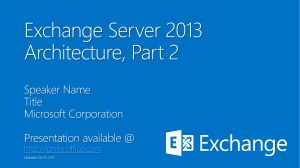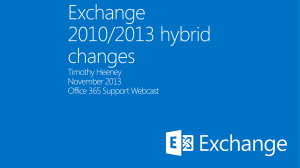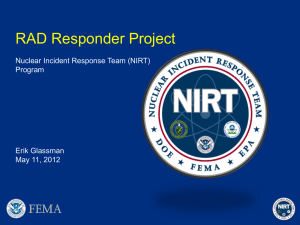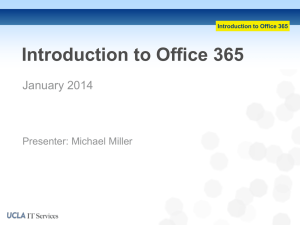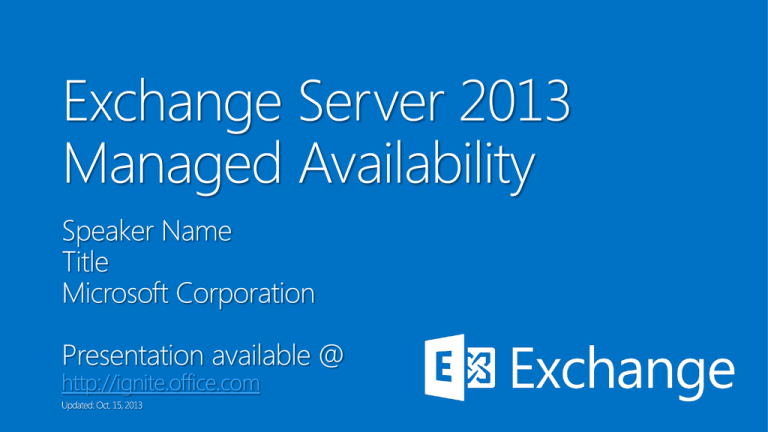
http://ignite.office.com
User
Exchange 2013 architecture
For a given mailbox’s connectivity, the
protocol being used is always served by
the server that hosts the active database
copy
Exchange Online service changed the
engineering approach to monitoring
Scale drives automation
Component based monitoring does not
tell the story
Layer 4LB
CAS
DAG1
MBX-A
MBX-A
MBX-B
MBX-B
Bringing the learnings
from the service to
the enterprise
Monitoring based
on the end user’s
experience
Protect user’s experience
through recovery
oriented computing
If you can’t measure it, you
cannot manage it
Customer Touch Points
Availability
Availability
Can I access the service?
Latency
How is my experience?
Errors
Am I able to accomplish what I
want?
Latency
Errors
“stuff breaks and the Experience does not”
LB
CAS-1
DAG
MBX-1
OWA
OWA
DB1
DB2
DB1
DB2
DB1
DB2
MBX-2
CAS-2
OWA
MBX-3
OWA
—OWA send
—OWA failure
—OWA fast recovery
—OWA verified as healthy
—OWA send
—OWA failure
—OWA fast recovery
—Failover server’s databases
—OWA verified as healthy
—Server becomes “good”
failover target (again)
Managed Availability
Exchange
2013
Server
“take human
driven action”
Managed
Availability
“state of the world”
“restore service or
prevent failure”
20s
5min
PROACTIVE
20min
REACTIVE
System Level Checks
Mailbox Self Test
(e.g. OWA MST) [detection 5m]
Protocol Self Test
(e.g. OWA PST) [detection 20 secs]
Proxy Self Test
(e.g. OWA PrST) [detection 20 secs]
End User Experience Level Checks
Customer Touch Point – CTP
(e.g. OWA CTP) [detection 20m]
“take human
driven action”
“state of the world”
“take human
driven action”
“restore service or
prevent failure”
Sampling
Probe
Definition
Probe
Probe
Results
(Samples)
Detection
Monitor
Definition
Monitor
Recovery
Monitor
Results
(Alerts)
Responder
Definition
Responder
Responder
Results
(Responses)
Monitor States
Healthy
Notification Item
00:00:00
Sequenced HA Responder
Pipeline Example
T1
Restart Responder
Reset AppPool
Responder
00:00:10
T2
Failover responder
Bugcheck responder
Offline Responder
00:00:30
T3
Escalate Responder
Named Times
Recovery Action Enabled
Per Server
Per Group
Minutes Between
Actions
Max Allowed
Per Hour
Max Allowed
Per Day
Minutes
Between Actions
Max Allowed
Per Day
ForceReboot
True
720
N/A
1
600
4
SystemFailover
True
60
N/A
1
60
4
RestartService
True
60
N/A
1
60
4
ResetIISPool
True
60
N/A
1
60
4
DatabaseFailover
True
120
N/A
1
120
4
ComponentOffline
True
60
N/A
1
60
4
ComponentOnline
True
5
12
288
5
Large
MoveClusterGroup
True
240
N/A
1
480
3
ResumeCatalog
True
5
4
8
5
12
WatsonDump
True
480
N/A
1
720
4
CTP
Health Set
Proxy
Health Set
OWA.Proxy
OWA
Protocol
Health Set
OWA.Protocol
Get-ServerHealth can be used to see raw health data for a server or a set of servers
Get-HealthReport operates on the raw health data and provides a snapshot report
How do you determine what probes, monitors and responders are associated with a given health set?
Get-MonitoringItemIdentity –Identity <HealthSet> -Server <ServerName>
View Overrides
Get-ServerMonitoringOverride –Server <Server>
Get-GlobalMonitoringOverride
Create Override
Add-ServerMonitoringOverride <HealthSet>\<Name> -Server <Server> -ItemType
<Monitor,Probe,Responder> [-Duration <Time> -ApplyVersion <Version>]
-PropertyName <Property> -PropertyValue <Value>
Add-GlobalMonitoringOverride <HealthSet>\<Name> -ItemType
<Monitor,Probe,Responder> [-Duration <Time> -ApplyVersion <Version>]
-PropertyName <Property> -PropertyValue <Value>
Remove Override
Remove-ServerMonitoringOverride
Remove-GlobalMonitoringOverride
Note that when an alert is exposed in SCOM, it may not be the sum total of problems at a given
point in time
Active Alerts
Organization Health
Server Health
The state of a health group is
computed based on the health of the
monitors within the group
A health group can have one of six
states: Healthy, Degraded, Unhealthy,
Repairing, Disabled or Unavailable
The health of the grouping will be
evaluated by a “worst of” evaluation
of the monitors in the group
Managed Availability + Retries…“stuff breaks and the Experience does not”
NLB
CAS-1
DAG
MBX-1
OWA
DB1
DB2
DB1
DB2
DB1
DB2
MBX-2
CAS-2
OWA
MBX-3
OWA
26
—OWA send
—OWA failure
—OWA failure detected
—OWA restart App pool
—OWA restart complete
—OWA verified as healthy
—OWA send
—OWA failure
—OWA failure detected
—OWA restart App pool
—OWA restart failed
—Failover server’s
databases
—OWA service restarts
—OWA verified as healthy
—Server becomes “good”
failover target (again)
Bringing the learnings
from the service to
the enterprise
Monitoring based
on the end user’s
experience
Protect user’s experience
through recovery
oriented computing
© 2013 Microsoft Corporation. All rights reserved. Microsoft, Windows, and other product names are or may be registered trademarks and/or trademarks in the U.S. and/or other countries.
The information herein is for informational purposes only and represents the current view of Microsoft Corporation as of the date of this presentation. Because Microsoft must respond to changing market conditions, it should not be interpreted to be a commitment on the
part of Microsoft, and Microsoft cannot guarantee the accuracy of any information provided after the date of this presentation. MICROSOFT MAKES NO WARRANTIES, EXPRESS, IMPLIED OR STATUTORY, AS TO THE INFORMATION IN THIS PRESENTATION.

